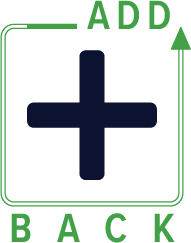Small Business Loan Refinancing
for Professional Practices
Get Un-Stuck From Your High Rate Variable SBA Loan
Are you feeling stuck in your high interest SBA loan? AddBack’s network of lenders can help you regain control and improve cash flow by refinancing your high interest variable rate SBA loan to a lower fixed rate business loan today!
Our Clients Have Seen Substantial Savings
Please note, every circumstance is unique and savings can vary based on your unique circumstances. Figures below based on $1m financed.
Average Monthly Savings Our Clients Have Realized
Average Annual Savings Our Clients Have Realized
The Benefits of Refinancing Your Small Business Loans
By choosing to refinance a SBA loan to a conventional loan, you’ll be able to access lower and fixed interest rates available in the conventional loan market and amortize them over a longer period of time immediately lowering your repayments and freeing up cash flow. Whether you have multiple loans, including commercial real estate or equipment loans, our refinancing solutions can help streamline your business debt finances.
Take the first step toward an easier-to-manage payment structure and overall improved financial stability—request an estimate today.


Get Preferential Terms
If you operate a successful medical, legal or accounting practice, you are more likely to obtain favorable refinancing terms that can make your business’s cash flow more manageable. Often, 100% debt refinancing is available based on payment history and credit score.
Don’t Get Caught Napping
The variable interest rate on your SBA loan is tied to the prime rate, which is in turn tied to the Federal Funds Target Rate (FFTR). The FFTR is set by the Federal Open Market Committee (FOMC) every 6 weeks and is projected to spike one more time before the end of 2023, before declining over the next 2 years at a much slower rate than originally predicted.
This has a direct impact on business owners with SBA loans in that the FFTR is used by all lending institutions to set their own prime rate which is then used to set all SBA loan rates. This means that without an immediate decline in the FFTR, there will be no decline in the variable SBA loan rate. Want to know more about how this works? Delve into the numbers here.
Since start-up practices with no collateral may have had no other choice but to take out the government-backed, high-interest variable SBA loans at the start, it is prudent to reassess once the practice has built up a stable book of business and regular payment history. If your professional practice has shown steady growth with consistent repayments but still requires funding, it may be eligible for very favorable refinancing.
It Doesn’t Hurt to Ask
Addback has a network of lenders that specialize in refinancing SBA loans to conventional loans for professional practices. Conventional loan rates are fixed and typically fall between 7% to 8% with 10 to 15 year amortization periods. The combined effect of the lower interest rate and longer amortization period immediately frees up cash that can be reinvested into the practice. It really doesn’t hurt to ask. If you have a medical, legal or accounting practice with an SBA loan, and you believe there is the slightest chance your practice could benefit from refinancing, just complete the eligibility check below.

Our Process
Step 1
Complete our “Check Eligibility” questionnaire form by clicking the button below.
Step 2
After eligibility is confirmed, a representative from AddBack will be in touch with next steps.
Step 3
We will reach out to finalize your total savings amount and work towards establishing a new loan to replace your high-interest SBA loan.
AddBack Solutions is Here to Help
We connect you with the right lender and provide you with all the information you need to make an educated business decision. And if you choose to proceed, we will work with you and your team to gather all the necessary documentation and make the process as seamless as possible.
SBA Refinancing Frequently Asked Questions
I want to understand the numbers...
The variable interest rate on your SBA loan is tied to the prime rate, which is in turn tied to the Federal Funds Target Rate (FFTR). The FFTR is set by the Federal Open Market Committee (FOMC) every 6 weeks and is projected to spike one more time before the end of 2023, before declining over the next 2 years at a much slower rate than originally predicted.
As at November 2023, FFTR is 5.5%. Lending institutions have used the same rule of thumb since 1994 to determine their prime rate and that is prime rate = FFTR + 3. This sets the prime rate at 8.5% (5.5%+3).
They then use the prime rate to determine the SBA loan rate depending on the amount requested and individual business risk. This can range anywhere from prime +3 to prime +6.5. This places SBA loan rates anywhere from 11% to 15%.
Is a conventional bank loan a good refinancing option?
Generally, conventional bank loans offer the lowest interest rates and best terms on business loans, which make them the first stop for many borrowers seeking financing or refinancing. Business loan interest rates vary by lender, but a range from 5% to 12% is common for small-business loans from banks.
What factors will a lender typically consider when evaluating a loan application and interest rate?
The lender will consider the borrower and the business to determine the following factors:
- Loan amount and terms.
- The borrower's creditworthiness, including the credit score (620 is the minimum, while 740 is more desirable).
- Business relationship with the lender.
- Operational longevity with companies with two years of operation and a proven track record is viewed more favorably.
- Some bank loans generally require an annual revenue of over $100,000.
Which businesses are classified as medical practices?
Among the businesses that fall into this category are:
- Chiropractic practices
- Dental practices
- Medical practices
- Nurse Practitioner-led practices,
- Ophthalmologist practices,
- Optometry practices,
- Physical Therapy practices
- Psychiatric and Counseling practices
- Veterinary practices
How can refinancing a small business loan help improve cash flow?
By refinancing high-interest small business loans to more affordable options with lower interest rates or longer loan terms, business owners can reduce their monthly payments. This frees up cash that can be allocated towards other aspects of the company's operations, ultimately improving the overall business's cash flow.
If variable interest rates are declining, why should I lock myself into a fixed rate?
Once you understand the numbers, the real question is when interest rates will begin to decline, and how long before they fall low enough to be competitive with a fixed interest rate on a conventional loan.
Since the fixed rate on a conventional loan would typically come in around 7% to 8%, SBA loan rates would have to reach around 8% for them to even begin to compete with a conventional loan rate.
For that to happen, the prime rate would have to drop to 5%, which means the FOMC would have to drop the FFTR to around 2%.
The FFTR is currently set at 5.5%, projected to spike one more time before the end of 2023, and then fall slowly over the next 2 years, with federal officials estimating that it could reach 3.9% by the end of 2025.
That represents a 2 year period over which you could be paying an unnecessarily high interest rate, at the end of which the SBA loan rate would still be higher than the fixed loan rate.
What factors should be considered when deciding to refinance a business loan?
Business owners should assess their current loan terms, outstanding loan balance, interest rate, and cash flow situation before considering refinancing. Other crucial factors include examining the potential for lower monthly payments, identifying prepayment penalties on existing debt, comparing lenders for competitive rates, and evaluating the impact of closing costs on the overall refinancing deal.

